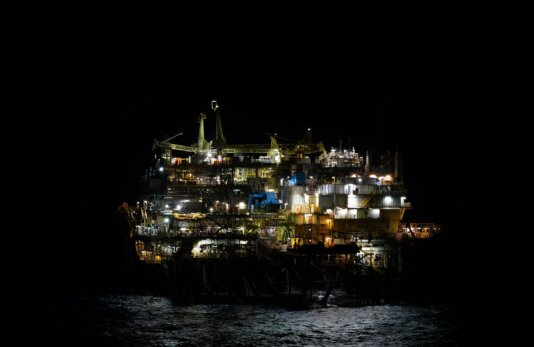- About
- Topics
- Story
- In-Depth
- Picks
- Opinion
- News
- Donate
- Signup for our newsletterOur Editors' Best Picks.Send
Read, Debate: Engage.
| topic: | Pollution |
|---|---|
| tags: | #COP30, #oil drilling |
| located: | Brazil |
| by: | John Amos |
As world leaders prepare to gather in Brazil for COP 30, the host nation's marine ecosystems are threatened by its growing fossil fuel industry. Our new analysis reveals how Brazil's offshore oil development, in particular, is leaving a trail of chronic pollution – at least 179 oil slicks since 2017, surging vessel traffic, and alarming methane emissions.
This problem is certainly not unique to Brazil, but this country also happens to be blessed with extraordinary natural wealth – the Amazon rainforest, the Pantanal wetlands, and some of the world's most biodiverse marine ecosystems – while simultaneously pursuing carbon-intensive energy expansion incompatible with the 1.5°C target set out in the landmark 2015 Paris Agreement to limit global warming.
Our investigation using satellite imagery and vessel tracking data documented a chronic pollution problem that has largely gone unnoticed. Of the 179 oil slicks we identified, 131 originated from vessels, with oil tankers and oil field service vessels responsible for nearly half of those with verifiable sources. This is not accidental spillage.
Much of what we observe likely represents intentional dumping of oily wastewater by commercial shippers who have evaded enforcement for decades despite international restrictions. This pollution threatens the very ecosystems that nourish coastal communities and enable Brazil’s thriving coastal tourism industry.
The scale of Brazil's offshore expansion compounds these risks dramatically. Oil production increased 49 per cent between 2014 and 2024, while natural gas surged 78 per cent. At one offshore production facility in the Santos Basin, vessel traffic jumped 430 per cent after operations began. Each new offshore facility demands more tankers, more service vessels, more coastal infrastructure – each element adding pollution stress to Brazil's waters and their remarkable biodiversity.
The Southwest Atlantic Humpback Migratory Corridor passes through the heavily industrialised Campos and Santos Basins, where we observed 73 oil slicks, 49 floating production vessels, and 20 operational platforms. Our analysis identified 20 important marine mammal areas covering over a quarter of Brazil's Exclusive Economic Zone – yet only 6 per cent of these critical habitats fall within marine protected areas, leaving 94 per cent unprotected.
The disconnect between the country's ambitious pledge to protect 30 per cent of its waters by 2030 and the reality of expanding offshore oil development in ecologically sensitive areas raises fundamental questions about how these commitments can coexist.
Perhaps most concerning are emerging findings about methane emissions. In a single data pass by Carbon Mapper’s satellite sensors over the Santos Basin in April 2025, we identified three simultaneous methane plumes from offshore infrastructure – each qualifying as a super-emitter event. Evidence from terrestrial oil and gas infrastructure, where much more data is available, suggests these emissions may be routine, indicating a significant and underreported climate problem.
Identifying and repairing methane leaks represents achievable climate action with immediate benefits. These leaks are technically fixable problems, making offshore methane monitoring a critical priority.

Image by SkyTruth.
And now, Brazil's environmental agency has approved the state oil company, Petrobras, to begin exploratory drilling near the mouth of the Amazon River – a decision that has generated debate, reflecting the broader tension between Brazil’s goals for economic development and its international climate leadership as host of COP30.
The path forward need not be predetermined. Brazil has an opportunity to pivot from this extractive legacy toward a future where ocean wealth is measured in healthy reefs, thriving fisheries, resilient coastal communities, and protected marine biodiversity. The nation's ecologically vital resources – from coral reefs to mangrove forests to critical marine mammal habitats – represent assets that can drive sustainable prosperity if protected. However, this opportunity is time-limited.
At a minimum, governments must end subsidies to fossil fuel industries and establish competitive parity with renewable energy. More effectively, these subsidies should be redirected to accelerate renewable energy development. Development banks funding these projects must impose stronger requirements for monitoring oil pollution, air pollution and methane emissions with clear standards for rapid response and remediation and enforceable timelines for transitioning to renewable sources.
The vessel pollution problem requires international cooperation. Brazil could provide leadership by championing a port state measures agreement for oil pollution, modeled on the successful framework used to combat illegal fishing. Under such an agreement, vessels documented polluting anywhere would face consequences when entering any signatory port – effectively closing enforcement gaps that operators currently exploit through flags of convenience, and providing a significant disincentive to continue doing business as usual.
We also need to address the root cause: commercial vessels continuing to burn heavy fuel oil, the dirtiest, most climate-polluting fuel available. Requiring cleaner fuels would eliminate much of this chronic pollution problem.
Brazil's coastal construction for energy facilities threatens mangroves, seagrasses and salt marshes – blue carbon habitats that are major carbon sinks. Their existence helps solve the climate challenge; their destruction accelerates it. These same habitats provide nursery grounds for commercially important fish species and protect coastlines from storm surges.
As Brazil hosts world leaders at COP 30, the convening represents an opportunity to align actions with commitments – to demonstrate that protecting 30 per cent of lands and waters by 2030 means genuinely prioritising environmental protection and long-term well-being for both its citizens and the global community.
The evidence is compelling. The stakes are high. Action is required now.
John Amos is the CEO of SkyTruth.
Image by Gabriel Xavier.
